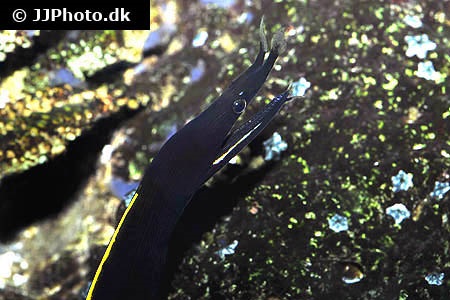Rhinomuraena quaesita
| Latin name | Rhinomuraena quaesita - Garman, 1888 |
|---|---|
| Local name | Ribbon moray |
| Family | Muraenidae - Rhinomuraena |
| Origin | East Indian Ocean, Australia, Japan, Indonesia, East Pacific, Central/West Pacific |
| Max length | 120 cm (47.2") |
| Minimum volume |
400 l (106 gal) |
|---|---|
| Hardiness |
Average |
| Suitable for aquarium |
Experience, preparation and extra care required |
| Reef safe |
Reef safe with caution |
| Aggressiveness | Peaceful |
| Recommended |
Fish Larger crustaceans (Shrimp, crabs...) |
|---|
This spicies might be a threat to smaller fishes.
This species can be a threat towards small crustaceans, e.g. small shrimp.
Morays can easily escape from aquaria, they can even move loose lids and glass covers without problems.
Morays should be fed a large meal every 3-4 days, as they otherwise can harm themselves by over eating.
If one has problems with getting the Morays to eat frozen fish or crustaceans, try moving the food in front of the fish with a tweezer.
Do note, that the food must be varied and raw/fresh, whole shrimps or smelt (small fish) for example.
It can take a week before they start feeding in the aquarium, but this is not a problem.
Try feeding them live fish or shrimp if the Morays iare not eating frozen foods after a week.
There is a greater chance of success with this species if one can supply a living feed to allow it to adapt to the tank.
This species has a habit of rearranging rocks and sand.
Make sure rocks are placed securely on the substrate, so they cannot toppled over.
These fish eat exceptionally slowly and can be very selective feeders.
It can therefore be problematic to provide it with a sufficient and varied diet, in an aquarium with other, faster feeding species.
This species needs good hiding places, for example, between live rocks.
This species can change gender from female to male.
When a male is needed, a female changes sex and takes on the role.
Moray eels (Muraenidae) are predatory fish that will most commonly live off fish or crustaceans.
To avoid overfeeding, the Moray must only be fed every 3-4 days, but may then also have a large meal.
They may dig up the substrate or move loose objects in the aquarium, so fastening the rocks and corals to the tank is a good idea.
Moray eels can easily escape from the tank if not tightly closed. They can lift lids and glass covers, do not underestimate their escape ability.
It is important that the Moray can, with its full length, hide between the rocks.
There are a few Moray eels which are suitable for reef aquaria, but the bigger species can only live in large tanks with other big fish.
Many Morays have a slightly poisonous bite, although it is not normally dangerous for people. One must not underestimate the strength of their bite however.
| Aquarium trade | Yes |
|---|---|
| Distribution | Indo-Pacific: East Africa to the Tuamoto Islands, north to southern Japan, south to New Caledonia and French Polynesia; including Marianas and Marshalls. |
| Danish common names |
Trådnæset muræne |
| French common names |
Murène ruban Rhinomurène bleue |
| English common names |
Black leafnosed moray eel Ribbon moray Ribbon eel |
Scott W. Michael. 2001. Reef Fishes volume 1 - TFH Publications / Microcosm Ltd. - (English)
Frank Marini. 2002. A Serpent For Your Reef Tank: A Look at Fish-Safe Eels - Reefkeeping Magazine - (English)
Mike Maddox. 2009. Morays! - Tropical Fish Hobbyist Magazine - (English)
Kirby Adams. Five Favorite Eels - Wet Web Media - (English)
Bob Fenner. The Moray Eels, Family Muraenidae, pt. 1 - Wet Web Media - (English)
Bob Fenner. The Moray Eels, Family Muraenidae, pt. 2, Less Aquarium Suitable Species - Wet Web Media - (English)
Marco Lichtenberger. 2007. Moray Eels Bite—But Are They Poisonous? - Tropical Fish Hobbyist - (English)




